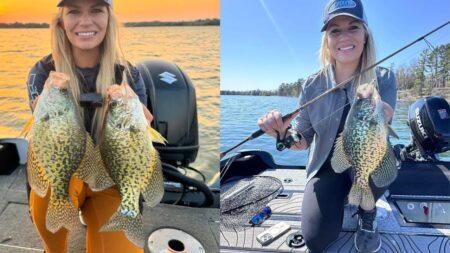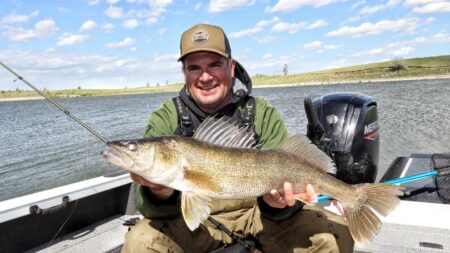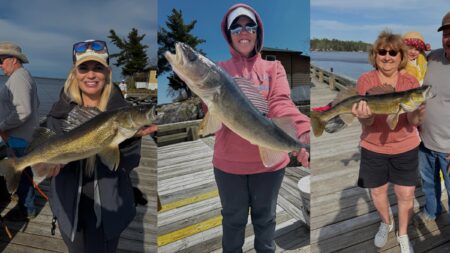After a week of practice for the NWT event on Winnebago, professional walleye angler Max Wilson was using the tried and true jig and crawler but found a slight modification improved the number and quality of bites he was getting.
Wilson noticed that a mayfly hatch has begun, which caused him to make a subtle change to his technique. Each day his approach changed slightly. On days that had a little bit of wind, the fish were positioned on the tops of rock reefs. Once the sun got higher in the sky they slid off the edges of the reefs, they were adjacent to the structure.
The technique change Wilson made was driving around, using his Livescope searching for individual fish, or pods of fish. He then dropped a Clam Pro Tackle Drop TG jig and crawler to those specific fish. The added weight from the tungsten jig got the worm down to the fish faster allowing him to “sharp shoot” the fish. The added speed on the drop also causes the crawler to kick or rotate more actively when falling.
Line is important when using this technique so Wilson uses 10 pound Seaguar AbrazX. When fishing hard structure like rock the abrasion resistance of fluorocarbon is a must. Wilson also prefers fluorocarbon because it allows you to feel the tungsten jig bouncing or dragging over rock as well as when the fish sucks in the bait.
There are two rods Wilson grabs when fishing this technique. The first is a 7’1″ JTX from JT Outdoor Products. It’s got enough backbone so he can really set the hook, but still sensitive enough so he can feel exactly what that fish is doing. “I can feel when he inhales it, I can feel when he is just sucking on the end of the crawler, and I can feel it when it’s time to set the hook,” Wilson explains.
When the bite slows down or there are flat calm conditions, he turns to the 7’3″ JTX. It’s a medium light which really allows the rod load up and the fish won’t feel a thing, and a strong enough backbone to bury the hook into the fish when needed.
This is a great technique for this time of year, not just on Lake Winnebago, but anywhere across the Midwest. When the mayflies start to hatch and the fish begin to transition off the rocks, crawler setups start to shine. Use the Livescope or SI to pinpoint fish, drop it right in front of their face and catch a lot more fish.




